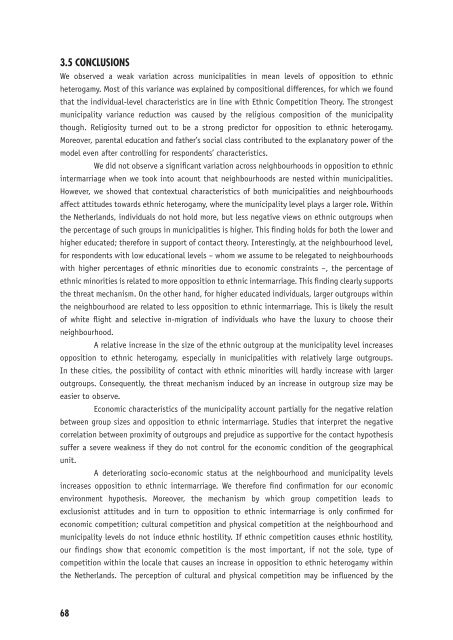Ethnic Hostility among Ethnic Majority and Minority Groups
Ethnic Hostility among Ethnic Majority and Minority Groups
Ethnic Hostility among Ethnic Majority and Minority Groups
You also want an ePaper? Increase the reach of your titles
YUMPU automatically turns print PDFs into web optimized ePapers that Google loves.
3.5 CONCLUSIONS<br />
We observed a weak variation across municipalities in mean levels of opposition to ethnic<br />
heterogamy. Most of this variance was explained by compositional differences, for which we found<br />
that the individual-level characteristics are in line with <strong>Ethnic</strong> Competition Theory. The strongest<br />
municipality variance reduction was caused by the religious composition of the municipality<br />
though. Religiosity turned out to be a strong predictor for opposition to ethnic heterogamy.<br />
Moreover, parental education <strong>and</strong> father’s social class contributed to the explanatory power of the<br />
model even after controlling for respondents’ characteristics.<br />
We did not observe a signifi cant variation across neighbourhoods in opposition to ethnic<br />
intermarriage when we took into acount that neighbourhoods are nested within municipalities.<br />
However, we showed that contextual characteristics of both municipalities <strong>and</strong> neighbourhoods<br />
affect attitudes towards ethnic heterogamy, where the municipality level plays a larger role. Within<br />
the Netherl<strong>and</strong>s, individuals do not hold more, but less negative views on ethnic outgroups when<br />
the percentage of such groups in municipalities is higher. This fi nding holds for both the lower <strong>and</strong><br />
higher educated; therefore in support of contact theory. Interestingly, at the neighbourhood level,<br />
for respondents with low educational levels – whom we assume to be relegated to neighbourhoods<br />
with higher percentages of ethnic minorities due to economic constraints –, the percentage of<br />
ethnic minorities is related to more opposition to ethnic intermarriage. This fi nding clearly supports<br />
the threat mechanism. On the other h<strong>and</strong>, for higher educated individuals, larger outgroups within<br />
the neighbourhood are related to less opposition to ethnic intermarriage. This is likely the result<br />
of white fl ight <strong>and</strong> selective in-migration of individuals who have the luxury to choose their<br />
neighbourhood.<br />
A relative increase in the size of the ethnic outgroup at the municipality level increases<br />
opposition to ethnic heterogamy, especially in municipalities with relatively large outgroups.<br />
In these cities, the possibility of contact with ethnic minorities will hardly increase with larger<br />
outgroups. Consequently, the threat mechanism induced by an increase in outgroup size may be<br />
easier to observe.<br />
Economic characteristics of the municipality account partially for the negative relation<br />
between group sizes <strong>and</strong> opposition to ethnic intermarriage. Studies that interpret the negative<br />
correlation between proximity of outgroups <strong>and</strong> prejudice as supportive for the contact hypothesis<br />
suffer a severe weakness if they do not control for the economic condition of the geographical<br />
unit.<br />
A deteriorating socio-economic status at the neighbourhood <strong>and</strong> municipality levels<br />
increases opposition to ethnic intermarriage. We therefore fi nd confi rmation for our economic<br />
environment hypothesis. Moreover, the mechanism by which group competition leads to<br />
exclusionist attitudes <strong>and</strong> in turn to opposition to ethnic intermarriage is only confi rmed for<br />
economic competition; cultural competition <strong>and</strong> physical competition at the neighbourhood <strong>and</strong><br />
municipality levels do not induce ethnic hostility. If ethnic competition causes ethnic hostility,<br />
our fi ndings show that economic competition is the most important, if not the sole, type of<br />
competition within the locale that causes an increase in opposition to ethnic heterogamy within<br />
the Netherl<strong>and</strong>s. The perception of cultural <strong>and</strong> physical competition may be infl uenced by the<br />
68












